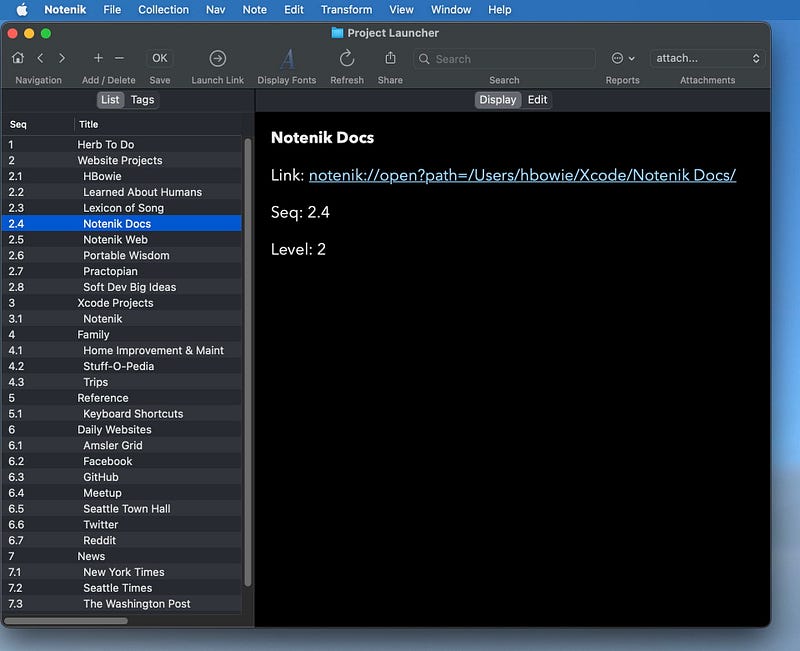Using Notenik as a Project Launcher on My Mac
Written on
Chapter 1: Introduction to Notenik
Recently, I've been utilizing Notenik on my Mac as a project launcher and wanted to share my setup process for those who might find it helpful. Notenik can be downloaded for free from the Mac App Store.
To simplify the explanation, I’ll outline a series of steps, although you’re not required to follow them in a strict order.
Section 1.1: Configuring Notenik Access
Request Access on Startup
Notenik doesn’t necessitate Full Disk Access by default, but granting it broader access can enhance your experience as a project launcher. To do this, navigate to Notenik's Application Preferences and set the Grant Access option to "At Startup." Each time you open Notenik, it will prompt you to select a folder for access. I typically select my main user directory (hbowie, in my case), allowing Notenik to access everything in my user folder without permission issues.
Creating Your Project Launcher
Begin by creating a New Collection, which can be stored anywhere; I prefer placing mine in the Notenik folder within iCloud Drive for easy access. You may initialize it as a Sequenced List, ensuring the Link, Seq, and Level fields are activated in your Collection Preferences. Use the Collection > Sort option to arrange your list by Seq + Title. I named mine "Project Launcher" for clarity.
Making the Project Launcher Essential
Use the File > Make This Collection Essential option to have it open automatically with Notenik. I position it in the upper left corner of my screen for convenience.
Adding Projects to Your Launcher
Start inserting notes into your project launcher, each containing a Link to a task or project. Once a Link is established, you can quickly launch it by double-clicking the corresponding note in the List tab. Utilize the Seq field to maintain your preferred order and the Level field for sub-items.
Incorporating Web Links
The most straightforward addition is a web URL in a Link field, allowing you to open the site later. A quick method is dragging a URL from your browser directly into the List tab. For automatic launch of specific sites upon opening your Project Launcher, assign them Tags labeled "Launch at Startup."
Connecting Other Notenik Collections
You can also link to another Notenik collection. For instance, I have a To Do collection stored in iCloud Drive that tracks regular tasks. It sits at the top of my Project Launcher, making it easy to access reminders for today’s tasks.
To add a Notenik collection, follow these steps:
- Open the collection you want to link.
- Under the Collection menu, select "Copy Notenik URL for Collection."
- Back in your project launcher, create a new note and paste the copied URL into the Link field.
Custom URL Actions
Notenik supports Custom URL Schemes, allowing you to initiate specific actions for Notenik or other applications using a launcher note.
Linking Local Files
While editing a new note, you can choose a local file to link by selecting "Set Local Link" from the Note menu. For example, linking to an Xcode project file enables it to open directly when the Link is activated.
Utilizing Notenik Parent Realms
A Parent Realm in Notenik is an ordinary folder containing resources such as Notenik collections or scripts. To create a launcher note for a parent realm, use the "Open Parent Realm" command in the File menu, then choose a folder with the desired items. You can then copy and paste the resulting Link into your project launcher.
Managing BBEdit Project Files
For each major project, I create a BBEdit project file saved in the parent realm folder. When I open a parent realm, I can easily access the BBEdit project file to work on the entire project folder.
Opening Folders in Finder
After opening a parent realm or collection, you can use the "Open Folder in Finder" option under the File menu to access the corresponding folder directly.
Bringing It All Together
When I launch Notenik, it requests the necessary disk access, which I grant. The project launcher opens in the upper left corner, where it remains throughout the day as I switch between projects. Each note in my launcher points to a parent realm for its respective project, allowing me to efficiently manage my tasks.
With this setup, I can transition smoothly between projects, manage collections, run scripts, and even open folders in BBEdit and Finder, making my workflow much more streamlined.
I hope this guide proves useful to you!

Chapter 2: Conclusion
Hope you find this setup as beneficial as I do!